2012 DACIA SANDERO check engine
[x] Cancel search: check enginePage 104 of 183
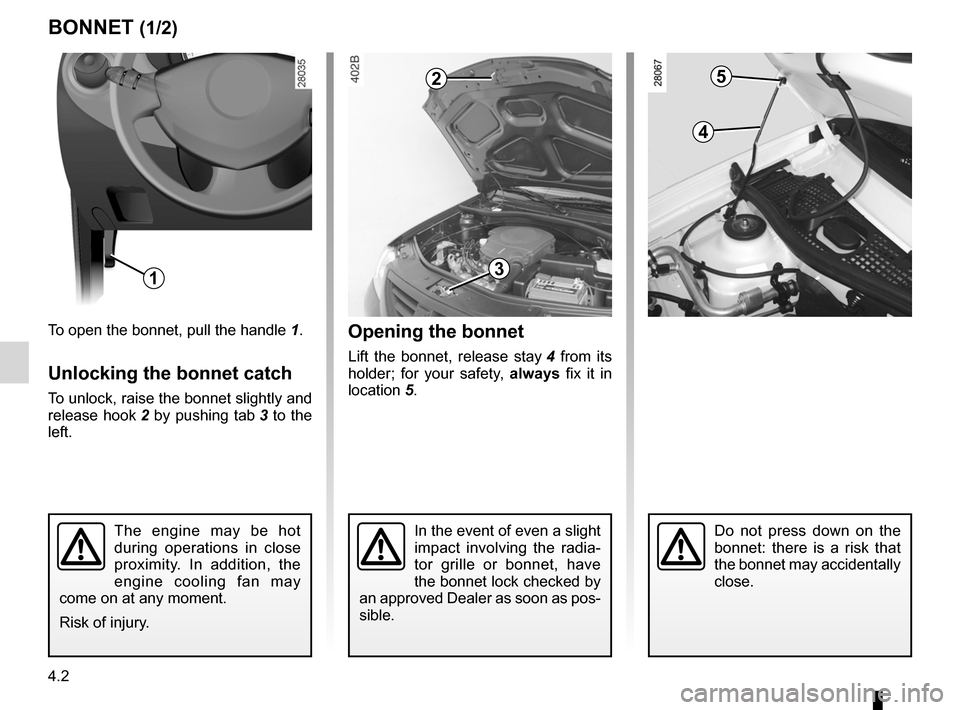
bonnet................................................... (up to the end of the DU)
4.2
ENG_UD22576_6
Capot moteur (B90 - Dacia)
ENG_NU_817-9_B90_Dacia_4
Jaune NoirNoir texte
Bonnet
BONNET (1/2)
The engine may be hot
during operations in close
proximity. In addition, the
engine cooling fan may
come on at any moment.
Risk of injury.In the event of even a slight
impact involving the radia -
tor grille or bonnet, have
the bonnet lock checked by
an approved Dealer as soon as pos-
sible.
1
2
3
4
5
To open the bonnet, pull the handle 1.
Unlocking the bonnet catch
To unlock, raise the bonnet slightly and
release hook 2 by pushing tab 3 to the
left.
Opening the bonnet
Lift the bonnet, release stay 4 from its
holder; for your safety, always fix it in
location 5.
Do not press down on the
bonnet: there is a risk that
the bonnet may accidentally
close.
Page 105 of 183
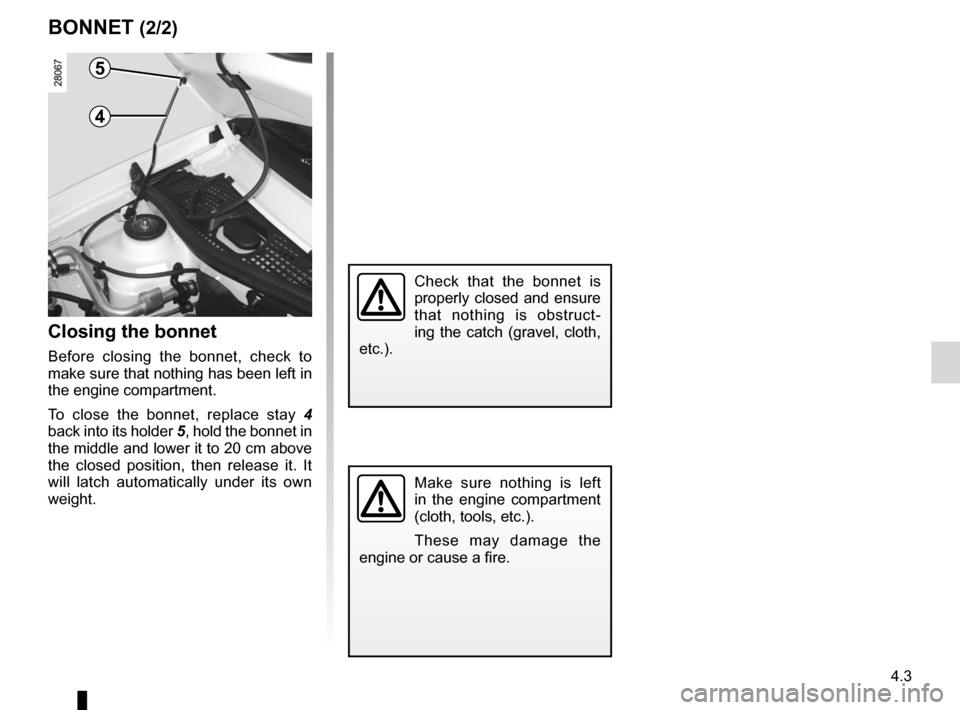
JauneNoirNoir texte
4.3
ENG_UD22576_6
Capot moteur (B90 - Dacia)
ENG_NU_817-9_B90_Dacia_4
BONNET (2/2)
Closing the bonnet
Before closing the bonnet, check to
make sure that nothing has been left in
the engine compartment.
To close the bonnet, replace stay 4
back into its holder 5, hold the bonnet in
the middle and lower it to 20 cm above
the closed position, then release it. It
will latch automatically under its own
weight.
Check that the bonnet is
properly closed and ensure
that nothing is obstruct -
ing the catch (gravel, cloth,
etc.).
4
5
Make sure nothing is left
in the engine compartment
(cloth, tools, etc.).
These may damage the
engine or cause a fire.
Page 106 of 183
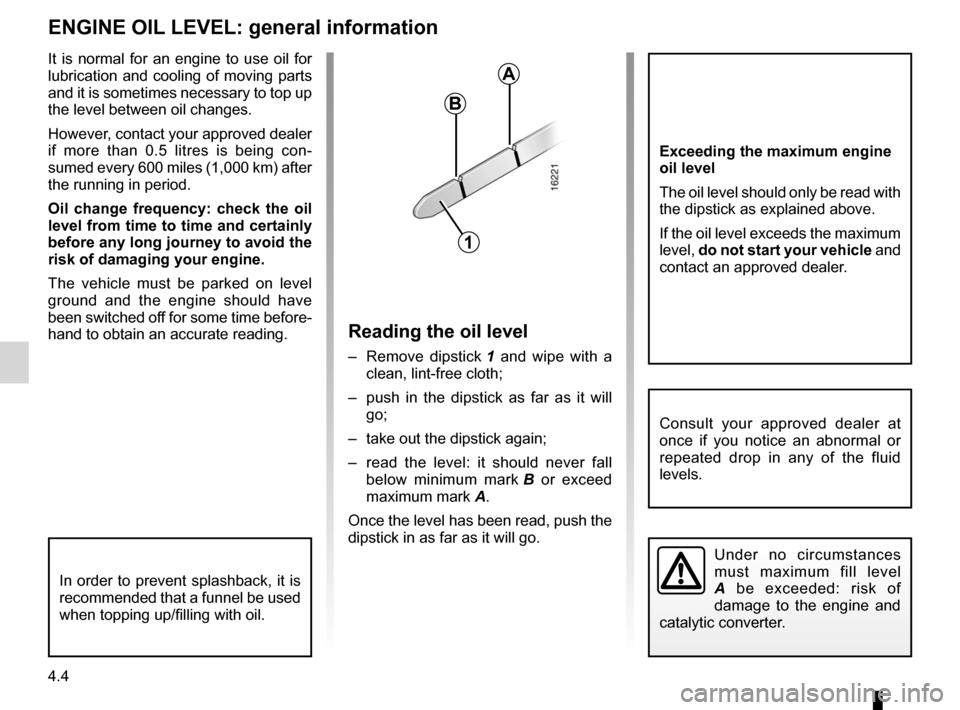
4.4
ENG_UD18250_2
Niveau huile moteur : généralités (B90 - L90 Ph2 - F90 Ph2 - R\
90 Ph2 - Dacia)
ENG_NU_817-9_B90_Dacia_4
It is normal for an engine to use oil for
lubrication and cooling of moving parts
and it is sometimes necessary to top up
the level between oil changes.
However, contact your approved dealer
if more than 0.5 litres is being con -
sumed every 600 miles (1,000 km) after
the running in period.
Oil change frequency: check the oil
level from time to time and certainly
before any long journey to avoid the
risk of damaging your engine.
The vehicle must be parked on level
ground and the engine should have
been switched off for some time before-
hand to obtain an accurate reading.
Engine oil level: general information
ENGINE OIL LEVEL: general information
Reading the oil level
– Remove dipstick 1 and wipe with a
clean, lint-free cloth;
– push in the dipstick as far as it will
go;
– take out the dipstick again;
– read the level: it should never fall
below minimum mark B or exceed
maximum mark A.
Once the level has been read, push the
dipstick in as far as it will go.
A
B
1
Exceeding the maximum engine
oil level
The oil level should only be read with
the dipstick as explained above.
If the oil level exceeds the maximum
level, do not start your vehicle and
contact an approved dealer.
Under no circumstances
must maximum fill level
A be exceeded: risk of
damage to the engine and
catalytic converter.
Consult your approved dealer at
once if you notice an abnormal or
repeated drop in any of the fluid
levels.
In order to prevent splashback, it is
recommended that a funnel be used
when topping up/filling with oil.
Page 107 of 183
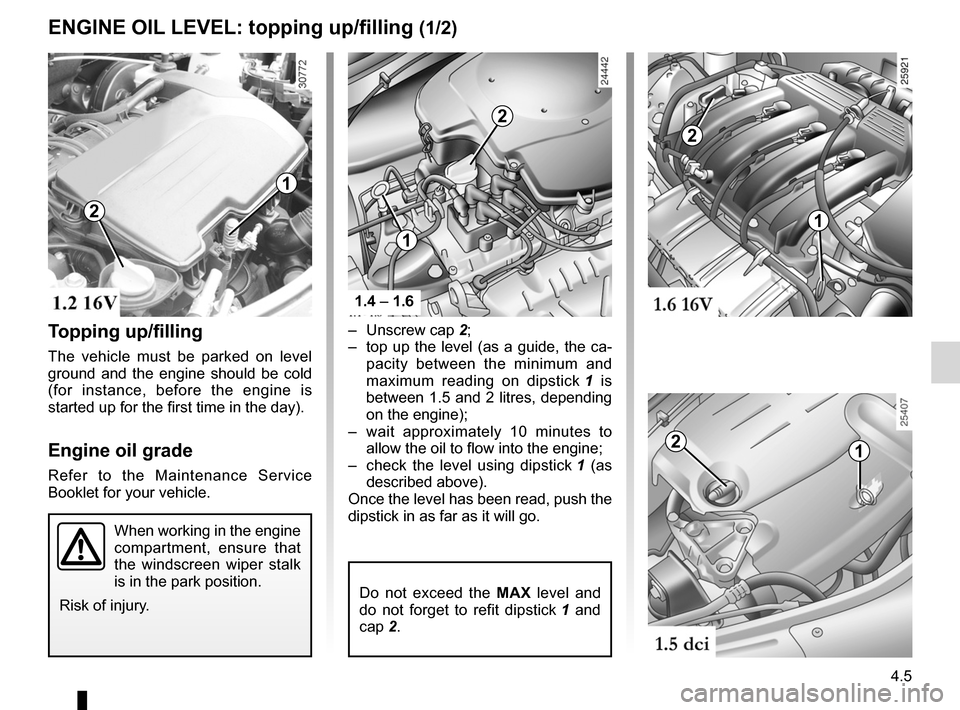
engine oil grade .................................... (up to the end of the DU)
levels: engine oil ......................................................... (current page)
4.5
ENG_UD19757_10
Niveau huile moteur : appoint / remplissage (B90 - L90 Ph2 - Dacia)
ENG_NU_817-9_B90_Dacia_4
Engine oil level: topping up/filling
ENGINE OIL LEVEL: topping up/filling (1/2)
Topping up/filling
The vehicle must be parked on level
ground and the engine should be cold
(for instance, before the engine is
started up for the first time in the day).
Engine oil grade
Refer to the Maintenance Service
Booklet for your vehicle. –
Unscrew cap 2;
– top up the level (as a guide, the ca-
pacity between the minimum and
maximum reading on dipstick 1 is
between 1.5 and 2 litres, depending
on the engine);
– wait approximately 10 minutes to
allow the oil to flow into the engine;
– check the level using dipstick 1 (as
described above).
Once the level has been read, push the
dipstick in as far as it will go.
When working in the engine
compartment, ensure that
the windscreen wiper stalk
is in the park position.
Risk of injury.
2
1
1.4 – 1.6
21
2
1
Do not exceed the MAX level and
do not forget to refit dipstick 1 and
cap 2.
2
1
Page 109 of 183
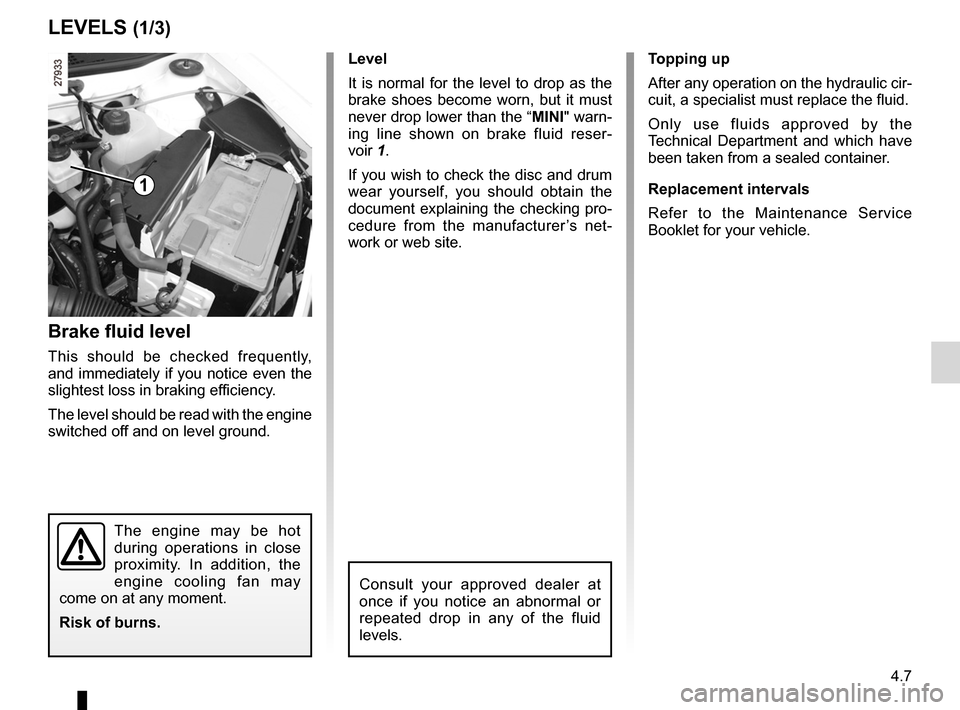
maintenance:mechanical ...................................... (up to the end of the DU)
brake fluid .............................................................. (current page)
levels .................................................... (up to the end of the DU)
tanks and reservoirs brake fluid ........................................................ (current page)
4.7
ENG_UD19766_9
Niveaux / Filtres (B90 - L90 Ph2 - Dacia)
ENG_NU_817-9_B90_Dacia_4
Levels:
Brake fluid
LEVELS (1/3)
Brake fluid level
This should be checked frequently,
and immediately if you notice even the
slightest loss in braking efficiency.
The level should be read with the engine
switched off and on level ground. Level
It is normal for the level to drop as the
brake shoes become worn, but it must
never drop lower than the “MINI" warn-
ing line shown on brake fluid reser
-
voir 1.
If you wish to check the disc and drum
wear yourself, you should obtain the
document explaining the checking pro-
cedure from the manufacturer ’s net -
work or web site.
1
Consult your approved dealer at
once if you notice an abnormal or
repeated drop in any of the fluid
levels.
The engine may be hot
during operations in close
proximity. In addition, the
engine cooling fan may
come on at any moment.
Risk of burns.
Topping up
After any operation on the hydraulic cir-
cuit, a specialist must replace the fluid.
Only use fluids approved by the
Technical Department and which have
been taken from a sealed container.
Replacement intervals
Refer to the Maintenance Service
Booklet for your vehicle.
Page 110 of 183

engine coolant ....................................................... (current page)
tanks and reservoirs coolant ............................................................. (current page)
tanks and reservoirs: windscreen washer .......................................... (current page)
4.8
ENG_UD19766_9
Niveaux / Filtres (B90 - L90 Ph2 - Dacia)
ENG_NU_817-9_B90_Dacia_4
Jaune NoirNoir texte
Engine coolant
Windscreen washer reservoir
Coolant
With the engine switched off and on
level ground, the level when cold must
be between the “ MINI" and “ MAXI"
marks on reservoir 2.
Top this level up when cold before it
reaches the “MINI" mark.
No operations should be
carried out on the cooling
circuit when the engine is
hot.
Risk of burns.
Checking intervals
Check the coolant level regularly
(very severe damage is likely to be
caused to the engine if it runs out of
coolant).
If the level needs to be topped up, only
use products approved by our Technical
Department which ensure:
– protection against freezing;
– anti-corrosion protection of the cool-
ing system.
Replacement intervals
Refer to the Maintenance Service
Booklet for your vehicle.
Consult an approved dealer at once
if you notice an abnormal or re -
peated drop in any of the fluid levels.
LEVELS (2/3)
2
The engine may be hot
during operations in close
proximity. In addition, the
engine cooling fan may
come on at any moment.
Risk of burns.
Windscreen washer reservoir
Filling: Remove cap 3, fill until you can
see the fluid, then refit the cap.
This reservoir supplies the front and
rear screen washers.
Liquid: Special windscreen washer
fluid (anti-freeze product in winter).
Jets: to adjust the angle of the jets
pivot the little ball using a pin.
Use products approved by the Technical
Department.
3
Page 112 of 183
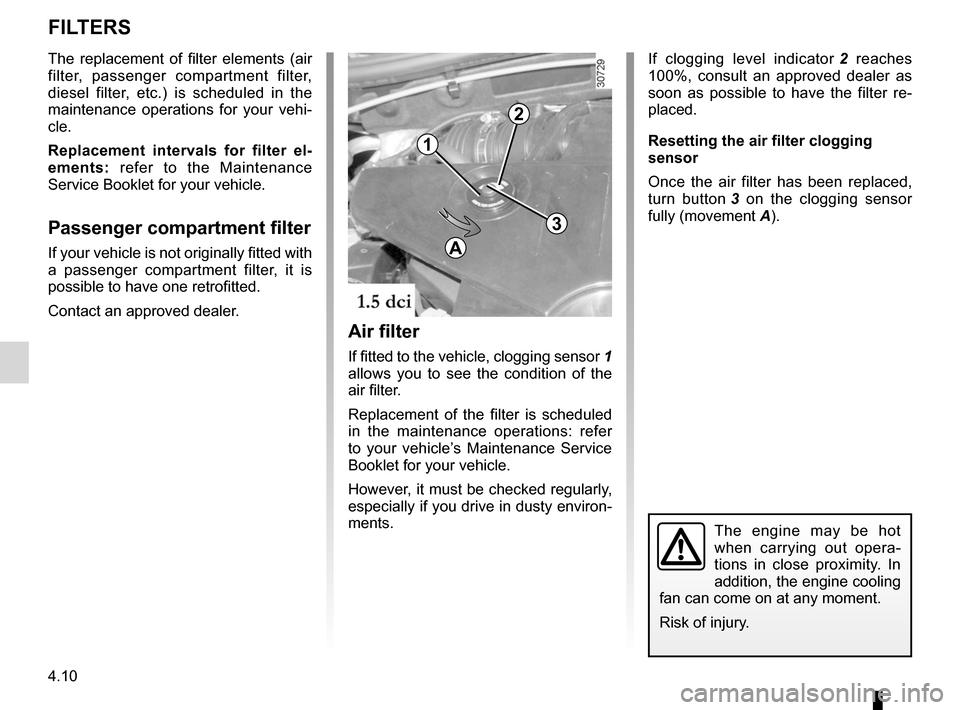
filterair filter ............................................................. (current page)
filter diesel filter ........................................................ (current page)
filter ........................................................................\
(current page)
filter passenger compartment filter .......................... (current page)
4.10
ENG_UD20151_3
Filtres (B90 - U90 - L90 Ph2 - F90 Ph2 - R90 Ph2 - H79 - Dacia)
ENG_NU_817-9_B90_Dacia_4
Filters
FILTERS
The replacement of filter elements (air
filter, passenger compartment filter,
diesel filter, etc.) is scheduled in the
maintenance operations for your vehi -
cle.
Replacement intervals for filter el -
ements: refer to the Maintenance
Service Booklet for your vehicle.
Passenger compartment filter
If your vehicle is not originally fitted with
a passenger compartment filter, it is
possible to have one retrofitted.
Contact an approved dealer.
The engine may be hot
when carrying out opera -
tions in close proximity. In
addition, the engine cooling
fan can come on at any moment.
Risk of injury.
Air filter
If fitted to the vehicle, clogging sensor 1
allows you to see the condition of the
air filter.
Replacement of the filter is scheduled
in the maintenance operations: refer
to your vehicle’s Maintenance Service
Booklet for your vehicle.
However, it must be checked regularly,
especially if you drive in dusty environ -
ments.
If clogging level indicator 2 reaches
100%, consult an approved dealer as
soon as possible to have the filter re -
placed.
Resetting the air filter clogging
sensor
Once the air filter has been replaced,
turn button 3 on the clogging sensor
fully (movement A).
1
2
3
A
Page 114 of 183
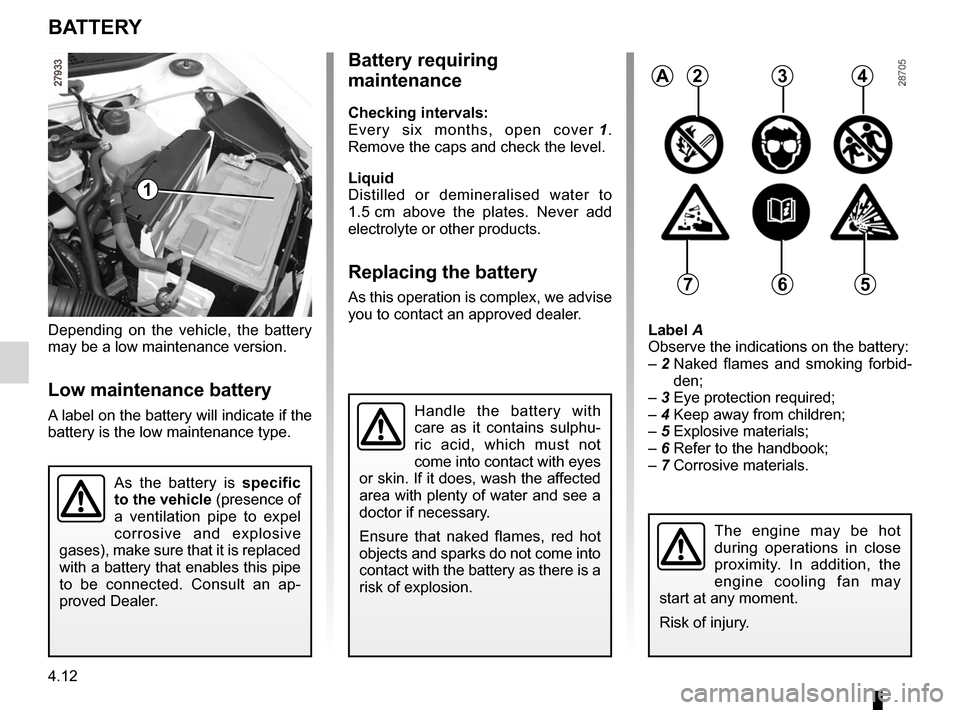
battery................................................... (up to the end of the DU)
capacity of mechanical components ......................(current page)
maintenance: mechanical ....................................................... (current page)
4.12
ENG_UD18253_10
Batterie (B90 - U90 - L90 Ph2 - F90 Ph2 - R90 Ph2 - Dacia)
ENG_NU_817-9_B90_Dacia_4
Battery
BATTER y
Depending on the vehicle, the battery
may be a low maintenance version.
Low maintenance battery
A label on the battery will indicate if the
battery is the low maintenance type.
As the battery is specific
to the vehicle (presence of
a ventilation pipe to expel
corrosive and explosive
gases), make sure that it is replaced
with a battery that enables this pipe
to be connected. Consult an ap -
proved Dealer.
Battery requiring
maintenance
Checking intervals:
Every six months, open cover 1 .
Remove the caps and check the level.
Liquid
Distilled or demineralised water to
1.5 cm above the plates. Never add
electrolyte or other products.
Replacing the battery
As this operation is complex, we advise
you to contact an approved dealer.
Handle the battery with
care as it contains sulphu -
ric acid, which must not
come into contact with eyes
or skin. If it does, wash the affected
area with plenty of water and see a
doctor if necessary.
Ensure that naked flames, red hot
objects and sparks do not come into
contact with the battery as there is a
risk of explosion.
1
Label A
Observe the indications on the battery:
– 2 Naked flames and smoking forbid -
den;
– 3 Eye protection required;
– 4 Keep away from children;
– 5 Explosive materials;
– 6 Refer to the handbook;
– 7 Corrosive materials.
The engine may be hot
during operations in close
proximity. In addition, the
engine cooling fan may
start at any moment.
Risk of injury.
A234
567